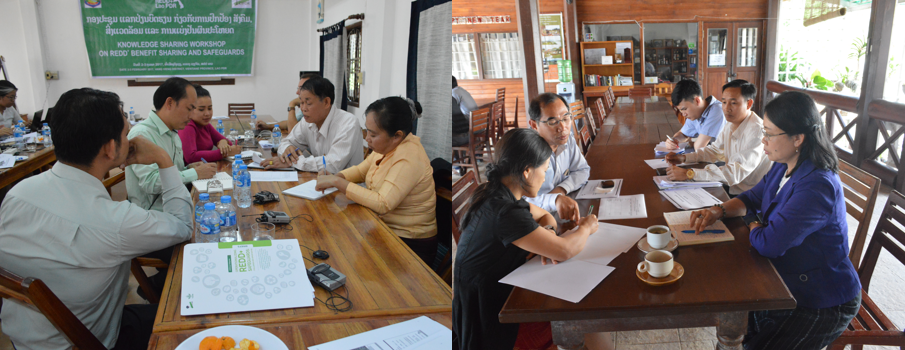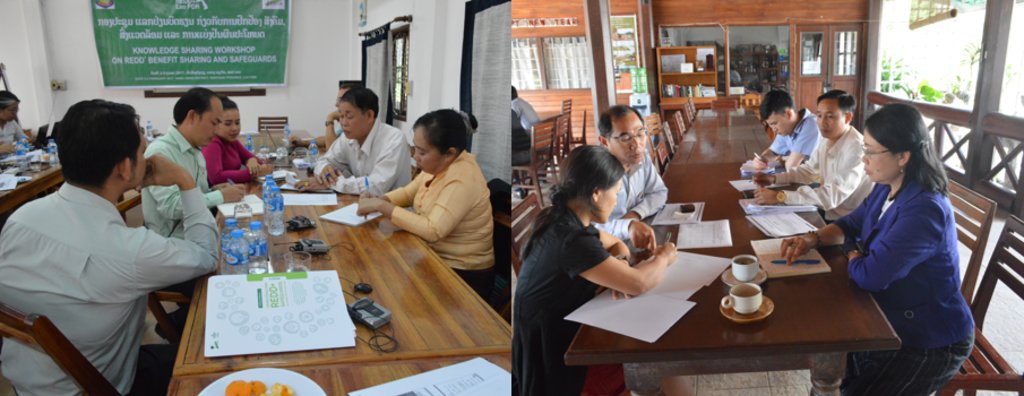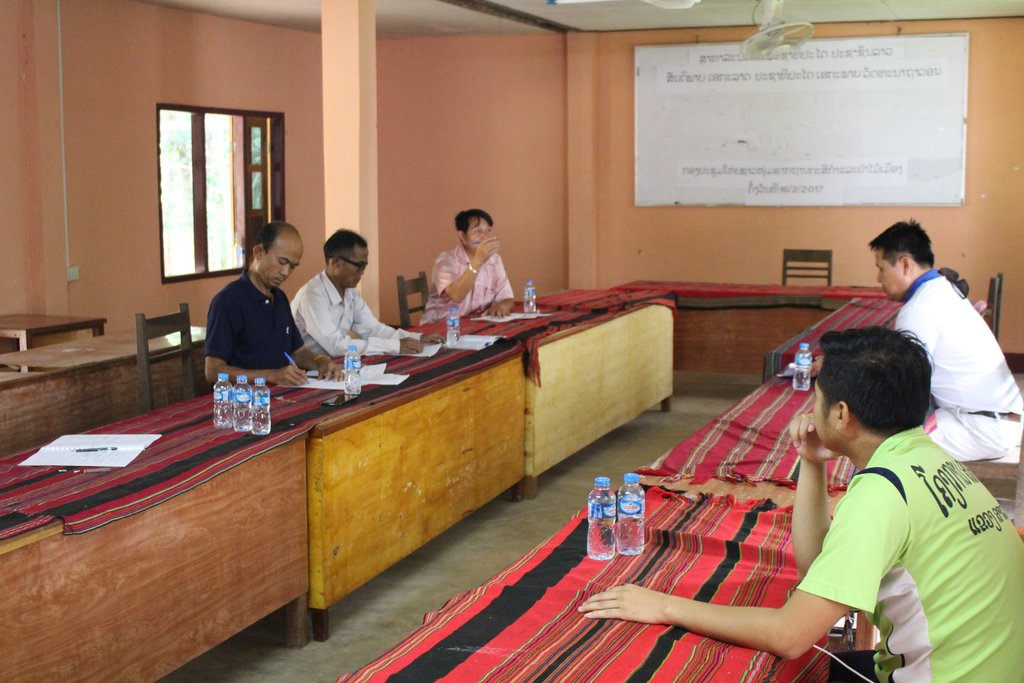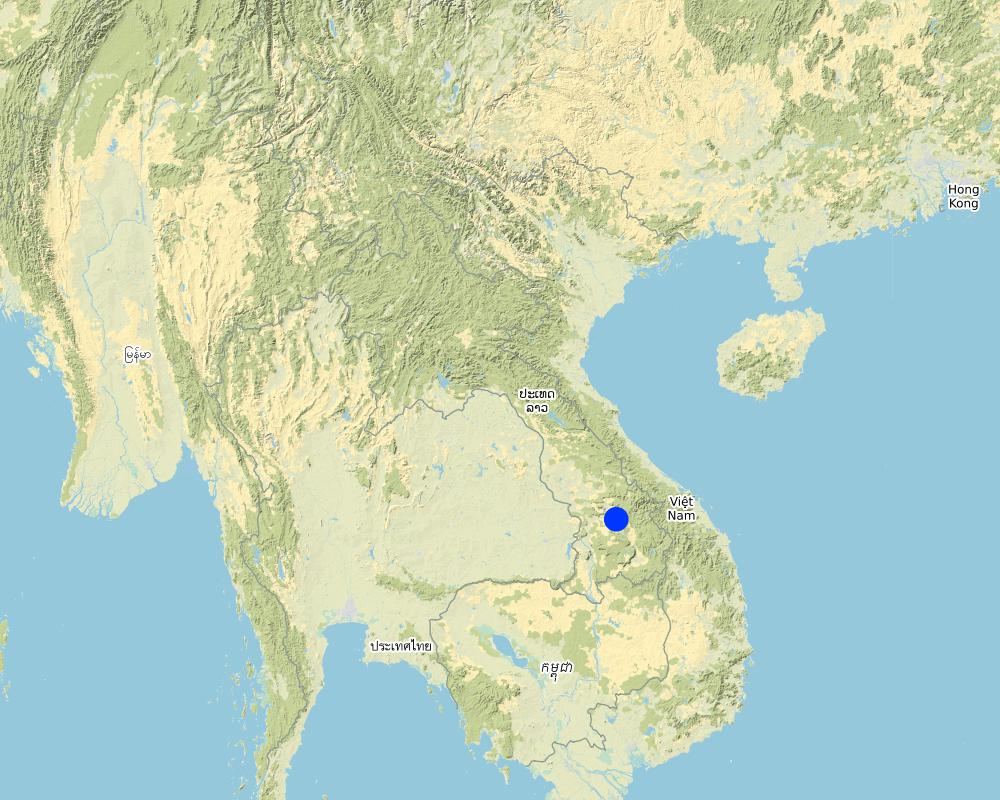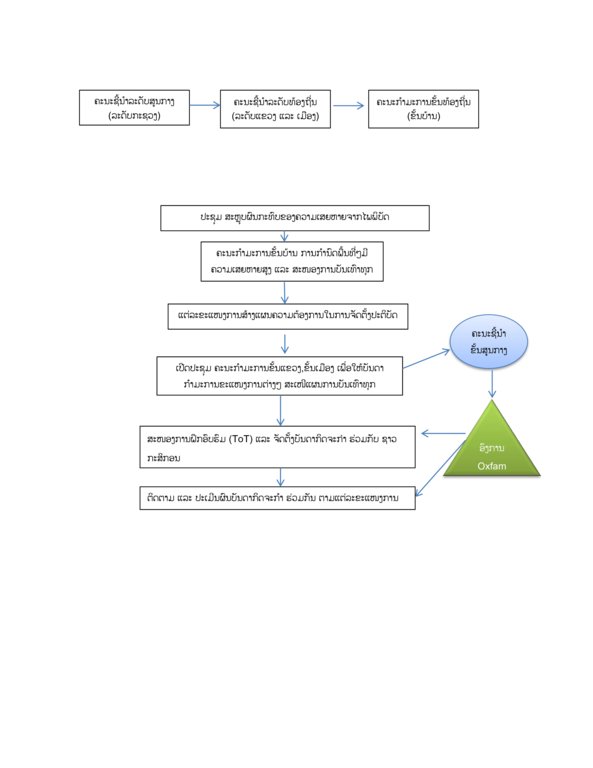The Upland Community Disaster Risk Reduction Project [Lao People's Democratic Republic]
- Creation:
- Update:
- Compiler: Pasalath Khounsy
- Editor: Bounthanom Bouahom
- Reviewers: Nicole Harari, William Critchley
approaches_3218 - Lao People's Democratic Republic
View sections
Expand all Collapse all1. General information
1.2 Contact details of resource persons and institutions involved in the assessment and documentation of the Approach
Key resource person(s)
land user:
Malichanse Soukkaseum
smalychansy@gmail.com
Oxfam Australia in Saravan province
Lao People's Democratic Republic
District steering committee:
Vilaysak Seuth
Taouy District of Agriculture and Forestry Office
Lao People's Democratic Republic
District steering committee:
Keokhamma Boutsa
ໍ+8562099704868
TaOuy District Labour and Social Welfare Office
Lao People's Democratic Republic
Name of project which facilitated the documentation/ evaluation of the Approach (if relevant)
Scaling-up SLM practices by smallholder farmers (IFAD)Name of the institution(s) which facilitated the documentation/ evaluation of the Approach (if relevant)
National Agriculture and Forestry Research Institute (NAFRI) - Lao People's Democratic Republic1.3 Conditions regarding the use of data documented through WOCAT
When were the data compiled (in the field)?
31/08/2017
The compiler and key resource person(s) accept the conditions regarding the use of data documented through WOCAT:
Ja
2. Description of the SLM Approach
2.1 Short description of the Approach
The disaster risk reduction project in upland communities aims to increase understanding about disaster management, disaster risk reduction, and community resilience. The main activities include emergency response during floods/droughts, reduction of impacts from disease outbreaks, livestock revolving funds, and village rice banks.
2.2 Detailed description of the Approach
Detailed description of the Approach:
The disaster risk reduction project in upland communities was established after the Ketsana typhoon hit the southern region of Lao PDR in 2008, causing significant losses to assets, infrastructure, and agricultural land. The project was approved by the Ministry of Labour and Social Welfare, and Ministry of Planning and Investment to be implemented at community level through a project steering committee which included the deputy provincial governor. The district governor was the project director at the local level based on an action plan developed by the ministries concerned with assistance from Oxfam Australia. This action plan was aimed at disaster prevention and control. The project coordinators came from the relevant government agencies including the District Labour and Social Welfare Office, the District Agriculture and Forestry Office, the District Administration Office, the District Health Office, the District of Natural Resources and Environment Office, and mass organizations (Women’s Union, Youth Union, Trades Union, and Lao Front for National Construction). The key project aims are to increase understanding about disaster management, disaster risk reduction, and community resilience. The main activities to be implemented include emergency response during floods/droughts, reduction of impacts from disease outbreaks, livestock revolving funds, and village rice banks. In the agriculture sector, the project promotes integrated crop cultivation (maize, beans, lemons, etc), a particular rice planting method termed SRI (System of Rice Intensification), and household gardens. In addition, Oxfam Australia and the local government of Lao PDR in cooperation with Care International (Xekong Province), and the World Food Programme provided emergency response and relief, and sanitation. Although there are a number of organizations which have contributed to disaster risk reduction and emergency response, constraints remain such as the implementation of limited life projects, inadequate funding, and a lack of coordination in the province and districts.. Village Committees for Disaster Prevention and Control have been established with regular meetings and disaster awareness campaign activities implemented. The project outcomes demonstrated that the communities are satisfied with their active participation.
2.3 Photos of the Approach
2.5 Country/ region/ locations where the Approach has been applied
Country:
Lao People's Democratic Republic
Region/ State/ Province:
Saravan province
Further specification of location:
Taouy district
Map
×2.6 Dates of initiation and termination of the Approach
Indicate year of initiation:
2008
If precise year is not known, indicate approximate date when the Approach was initiated:
less than 10 years ago (recently)
Year of termination (if Approach is no longer applied):
2014
Comments:
There have been two different phase of project implementation. The first phase was from 1999-2001 and the second phase was 2008-2014.
2.7 Type of Approach
- project/ programme based
2.8 Main aims/ objectives of the Approach
The objectives of the project are to increase understanding about disaster management, disaster risk reduction, and community development in disaster impacted areas.
2.9 Conditions enabling or hindering implementation of the Technology/ Technologies applied under the Approach
social/ cultural/ religious norms and values
- enabling
Gender aspect – the project changed immoral traditional and cultural beliefs of people by encouraging men to have more involvement in household activities with women.
- hindering
The two different farmer’s groups in the village do not want to work together - including on establishment of village rice banks and water borehole drilling.
availability/ access to financial resources and services
- enabling
Provide greater opportunities to vulnerable households to participate in the project, encourage local communities to access finance and animals for their own operations.
institutional setting
- enabling
Established the district and village committees levels in order to support the construction and administration work.
collaboration/ coordination of actors
- enabling
Regular collaboration with various levels including provincial, district and village.
legal framework (land tenure, land and water use rights)
- enabling
policies
- enabling
land governance (decision-making, implementation and enforcement)
- enabling
knowledge about SLM, access to technical support
- enabling
markets (to purchase inputs, sell products) and prices
- enabling
Set up the Chinese pear selling group
workload, availability of manpower
- enabling
3. Participation and roles of stakeholders involved
3.1 Stakeholders involved in the Approach and their roles
- local land users/ local communities
Farmer’s group
Implementer
- community-based organizations
Village authorities and village organisation
Approve, certify and dissemination of key information
- SLM specialists/ agricultural advisers
District Agriculture and Forestry Office staffs
Supervise the project implementation and provide training
- NGO
Oxfam Project Staffs
Supervise the project implementation and provide training
- local government
Provincial Agriculture and Forestry Office and District of Agriculture and Forestry Office staffs
Leading, monitoring the implementation of the project and provide training
- national government (planners, decision-makers)
Central Administrative Office in Vientiane and Ministries level.
Consultaition and approve the project implementation at national level.
- international organization
Oxfam International Office
Financial support
3.2 Involvement of local land users/ local communities in the different phases of the Approach
| Involvement of local land users/ local communities | Specify who was involved and describe activities | |
|---|---|---|
| initiation/ motivation | interactive | |
| planning | interactive | |
| implementation | interactive | |
| monitoring/ evaluation | interactive | |
| Field exchange | interactive | Facilitate 20 staff and training on disaster management and 7 farmers from each village conducted the field exchange on rice production technologies. |
3.3 Flow chart (if available)
3.4 Decision-making on the selection of SLM Technology/ Technologies
Specify who decided on the selection of the Technology/ Technologies to be implemented:
- all relevant actors, as part of a participatory approach
Specify on what basis decisions were made:
- evaluation of well-documented SLM knowledge (evidence-based decision-making)
- personal experience and opinions (undocumented)
4. Technical support, capacity building, and knowledge management
4.1 Capacity building/ training
Was training provided to land users/ other stakeholders?
Ja
Specify who was trained:
- land users
- field staff/ advisers
Form of training:
- on-the-job
- farmer-to-farmer
Subjects covered:
The fund management, water supply uses, rice bank, veterinary, chicken raising, aquaculture, rice production, disaster risk preparedness and response, typhoon, forest fires, disaster warning equipment.
4.2 Advisory service
Do land users have access to an advisory service?
Ja
Specify whether advisory service is provided:
- on land users' fields
Describe/ comments:
Once per month
4.3 Institution strengthening (organizational development)
Have institutions been established or strengthened through the Approach?
- yes, moderately
Specify the level(s) at which institutions have been strengthened or established:
- local
Describe institution, roles and responsibilities, members, etc.
The district and village committees for disaster prevention and control are responsible for supervising, acting as focal points and reporting to the provincial and central levels.
Specify type of support:
- financial
- capacity building/ training
- equipment
4.4 Monitoring and evaluation
Is monitoring and evaluation part of the Approach?
Ja
Comments:
The M&E team of the Oxfam project organized a monthly monitoring meeting involving collaboration with the community board at village and district levels.
If yes, is this documentation intended to be used for monitoring and evaluation?
Ja
4.5 Research
Was research part of the Approach?
Ja
Specify topics:
- technology
Give further details and indicate who did the research:
A number of potentially appropriate activities have been modified to fit local conditions, such as: promotion economics / marketing of animal breeds that people never raised before.
5. Financing and external material support
5.1 Annual budget for the SLM component of the Approach
Indicate the annual budget for the SLM component of the Approach in US$:
100000.00
If precise annual budget is not known, indicate range:
- 10,000-100,000
Comments (e.g. main sources of funding/ major donors):
AUSAid funding source
5.2 Financial/ material support provided to land users
Did land users receive financial/ material support for implementing the Technology/ Technologies?
Ja
If yes, specify type(s) of support, conditions, and provider(s):
Financial supported by AUSAid and implemented by Oxfam Australia
5.3 Subsidies for specific inputs (including labour)
- labour
| To which extent | Specify subsidies |
|---|---|
| fully financed | local communities supplied labor and the project paid for this |
- construction
| Specify which inputs were subsidised | To which extent | Specify subsidies |
|---|---|---|
| stone | fully financed | |
| wood | partly financed | Villagers |
- infrastructure
| Specify which inputs were subsidised | To which extent | Specify subsidies |
|---|---|---|
| roads | fully financed | Project |
| schools | fully financed | Project |
If labour by land users was a substantial input, was it:
- food-for-work
5.4 Credit
Was credit provided under the Approach for SLM activities?
Nee
5.5 Other incentives or instruments
Were other incentives or instruments used to promote implementation of SLM Technologies?
Nee
6. Impact analysis and concluding statements
6.1 Impacts of the Approach
Did the Approach empower local land users, improve stakeholder participation?
- No
- Yes, little
- Yes, moderately
- Yes, greatly
Did the Approach enable evidence-based decision-making?
- No
- Yes, little
- Yes, moderately
- Yes, greatly
Did the Approach help land users to implement and maintain SLM Technologies?
- No
- Yes, little
- Yes, moderately
- Yes, greatly
Did the Approach improve coordination and cost-effective implementation of SLM?
- No
- Yes, little
- Yes, moderately
- Yes, greatly
Did the Approach mobilize/ improve access to financial resources for SLM implementation?
- No
- Yes, little
- Yes, moderately
- Yes, greatly
Did the Approach improve knowledge and capacities of land users to implement SLM?
- No
- Yes, little
- Yes, moderately
- Yes, greatly
Did the Approach improve knowledge and capacities of other stakeholders?
- No
- Yes, little
- Yes, moderately
- Yes, greatly
Did the Approach build/ strengthen institutions, collaboration between stakeholders?
- No
- Yes, little
- Yes, moderately
- Yes, greatly
Did the Approach mitigate conflicts?
- No
- Yes, little
- Yes, moderately
- Yes, greatly
Did the Approach empower socially and economically disadvantaged groups?
- No
- Yes, little
- Yes, moderately
- Yes, greatly
Did the Approach improve gender equality and empower women and girls?
- No
- Yes, little
- Yes, moderately
- Yes, greatly
Did the Approach encourage young people/ the next generation of land users to engage in SLM?
- No
- Yes, little
- Yes, moderately
- Yes, greatly
Did the Approach lead to improved food security/ improved nutrition?
- No
- Yes, little
- Yes, moderately
- Yes, greatly
Did the Approach improve access to markets?
- No
- Yes, little
- Yes, moderately
- Yes, greatly
Did the Approach lead to improved access to water and sanitation?
- No
- Yes, little
- Yes, moderately
- Yes, greatly
Did the Approach improve the capacity of the land users to adapt to climate changes/ extremes and mitigate climate related disasters?
- No
- Yes, little
- Yes, moderately
- Yes, greatly
The end of project, there is no follow up activity but some activity were went well especially for the rice bank.
Did the Approach lead to employment, income opportunities?
- No
- Yes, little
- Yes, moderately
- Yes, greatly
Some people have learned from the project and gained useful knowledge and experiences which has enabled them to find other employment opportunities.
6.2 Main motivation of land users to implement SLM
- increased production
- increased profit(ability), improved cost-benefit-ratio
- reduced risk of disasters
- reduced workload
- rules and regulations (fines)/ enforcement
- affiliation to movement/ project/ group/ networks
- environmental consciousness
- customs and beliefs, morals
- enhanced SLM knowledge and skills
6.3 Sustainability of Approach activities
Can the land users sustain what has been implemented through the Approach (without external support)?
- yes
If yes, describe how:
The rice production and animal breeding groups are able to maintain their initiatives. Gravity fed water supply system, school, road have been supported by other development organizations.
6.4 Strengths/ advantages of the Approach
| Strengths/ advantages/ opportunities in the land user’s view |
|---|
| Project implementation plan is parallel with the district development strategy and meets the needs of local people. |
| Build understanding on project management, project coordination in each level. |
| Continuous project monitoring for approximately 3 – 5 years. |
| Mobilization for participation in activities. |
| Strengths/ advantages/ opportunities in the compiler’s or other key resource person’s view |
|---|
| The project apply the participatory approach from early stage until monitoring phase. |
| Promotion of all concerned agencies and offices. |
| Detailed assessment for capacity building in planning for equipment/material supply, vehicles, staff visit the villages regularly. |
6.5 Weaknesses/ disadvantages of the Approach and ways of overcoming them
| Weaknesses/ disadvantages/ risks in the land user’s view | How can they be overcome? |
|---|---|
| The staff lack appropriate knowledge and skills | Provide more training on technical knowledges and skills and other relevant topics. |
| There is still a large gap to understanding on certain topics between officials and local communities. | On-the-job training, use video as a means for communication to increase local people’s understanding. |
| Dependency on project and government to implement activities. | |
| Some immoral traditional and cultural beliefs are still hindering development efforts. | It is recommended to increase awareness of village elders who can then influence the local people. |
| Weaknesses/ disadvantages/ risks in the compiler’s or other key resource person’s view | How can they be overcome? |
|---|---|
| Lack of financial resources to monitor project activities. | |
| There were issues with repayment to village development fund, animal revolving fund in order to rotate to other households. | The need to have a robust contract and revise regulations. |
| Delayed supply of materials which is impact to late activity implementation. | |
| Hand over of responsibilities to persons with insufficient capability. | Consider to transfer the activity to local implementers. |
7. References and links
7.1 Methods/ sources of information
- field visits, field surveys
1 time
- interviews with land users
2 land users
- interviews with SLM specialists/ experts
1SLM expertise
Links and modules
Expand all Collapse allLinks
No links
Modules
No modules


